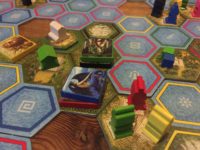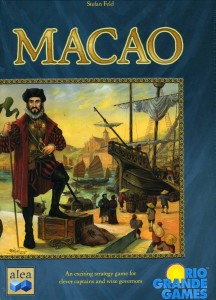- Learning time
- 40 minutes
- First play time
- 120 minutes
The Oracle of Delphi
Designed by: Stefan Feld
In The Oracle of Delphi the players are sea captains answering a challenge set by Zeus – can they complete the twelve tasks laid before them before the other players do?
The tasks consist of four things: make offerings, build shrines, erect statues, and defeat monsters. You can set up the modular board however you like, as long as all the water is connected, as you travel around it by ship. A smaller board in front of you keeps track of what your ship is carrying, what tasks you still need to complete, your shield strength (for fighting monsters) and your standing with the Gods – elevate a God to their highest position, and they will reward you with a lucrative one-off action…
The individual boards also have space for your oracle dice, which are the heart of the game. On every turn, these are rolled and you can choose how to spend them. It might be moving your ship, loading a statue or offering onto it, unloading the same at a desirable new location, building a shrine, and one or two other things. In every instance, the colour of the die you use must match the colour of the offering, statue, location, etc. When you complete a task, you gain a reward!
You can also spend dice irrespective of their colour, to pick up oracle cards (extra actions!) favour tokens (manipulate your dice, or help speed your ship!) or looking at two island tiles (locate the building site for your shrine!)
Once your dice are spent, your turn is over. When the last player goes, they roll the Titan dice. This is where everyone’s shield strength comes into play, as being weaker than the Titan means picking up wounds: there are ways to get rid of these, but if you pick up too many you end up missing a turn in order to recover.
Around this hectic moving/loading/moving/unloading are some extra bits and bobs going on – Equipment and Companion cards help you on your quests, battling monsters involves dice-rolling, and there’s the element of competition too: the game is a race, don’t forget, and your opponents will be grabbing stuff that you may have wanted for yourself. As soon as one player has completed all the tasks and returned to the starting place on the board, the game end is triggered and it’s a race to the line to catch them!
The guru's verdict
-
Take That!
Take That!
A little, in the sense that statues and offerings can be snatched up. But players are racing each other, not fighting each other.
-
Fidget Factor!
Fidget Factor!
High on a first play, dropping to a kind of staccato effect: some turns will fly by in seconds, others may invite pause for thought.
-
Brain Burn!
Brain Burn!
Your tasks are easily tracked, but achieving them depends on how you deal with the variables of dice-rolling. There's always a way to spend a die, but some rolls are better than others, and mitigating for this is key to succeeding.
-
Again Again!
Again Again!
The board can be set up any number of ways, you can play a shorter version of the game too. But what gives Delphi a lot of replayability - for those who enjoy the challenge - is the dice. Every turn throws up a fresh mini-challenge in how they are best spent.












Sam says
The board looks messy and chaotic on the table, and a first play is rather bewildering as you have so many options. But you may decide it's worth persisting with, because like most of Stefan Feld's games, the mechanics of what's going on are rather clever. Completing twelve tasks is a straightforward objective, but... in what order? You may have an embryonic Plan A in your head only to find the dice suggest another course of action. And because each task has a reward for completing it, there is a palpable sense of progress here; not only in ticking off another task, but in how much more achievable you've just made the next one. It's very absorbing.